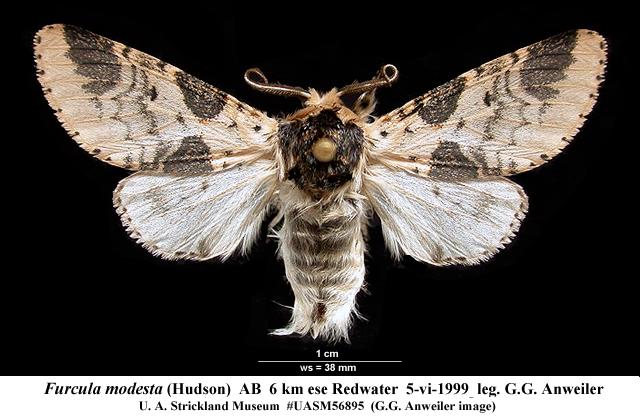« Back to your search
Species Details
Furcula modesta
University of Alberta E.H. Strickland Entomological Museum Read more about this collection »
Common NameModest Kitten
SeasonalityAdults are on the wing late May to July.
IdentificationA medium-sized (3.5-4.0 cm. wingspan) grey-black and white moth, with a cream or light tan cast to the white areas of the forewings. A broad black band crosses the median area of the forewings. It usually narrows in the middle, and in many specimens is divided into two wedge-shaped patches. Modesta can be separated from other Furcula sp. by the absence of yellow or gold scaling on the forewing where the lines cross the veins. Male modesta can also be separated from the other species of Furcula by the diamond shape of the laterally flattened uncus.
Scientific Name
Furcula modesta
Common Name
Modest Kitten
Habitat
Deciduous woodland and shrub.
Seasonality
Adults are on the wing late May to July.
Identification
A medium-sized (3.5-4.0 cm. wingspan) grey-black and white moth, with a cream or light tan cast to the white areas of the forewings. A broad black band crosses the median area of the forewings. It usually narrows in…
A medium-sized (3.5-4.0 cm. wingspan) grey-black and white moth, with a cream or light tan cast to the white areas of the forewings. A broad black band crosses the median area of the forewings. It usually narrows in the middle, and in many specimens is divided into two wedge-shaped patches. Modesta can be separated from other Furcula sp. by the absence of yellow or gold scaling on the forewing where the lines cross the veins. Male modesta can also be separated from the other species of Furcula by the diamond shape of the laterally flattened uncus.
Life History
Adults are nocturnal and come to light. The larvae are solitary defoliators. There is a single brood which overwinters in the pupal stage.
Conservation
No conservation concerns.
Diet Info
No Alberta data. Elsewhere reported larval hosts include aspen poplar (Populus tremuloides) and willows (Salix).
Range
Fom the Maritimes west across southern Canada to southeastern BC. In Alberta, found throughout the aspen parklands, southern boreal forest, foothills and lower elevations in the mountains. It apparently does not…
Fom the Maritimes west across southern Canada to southeastern BC. In Alberta, found throughout the aspen parklands, southern boreal forest, foothills and lower elevations in the mountains. It apparently does not occur as far north in the Boreal region as F. scolopendrina and F. occidentalis.
Specimen Information
There are 67 specimens of this Species.
UASM186993 - Furcula modesta
University of Alberta E.H. Strickland Entomological Museum
Place CollectedCanada: New Brunswick, Edmundston
Collected ByHensel, H.
Date Collected2001-08-02
UASM186994 - Furcula modesta
University of Alberta E.H. Strickland Entomological Museum
Place CollectedCanada: New Brunswick, Edmundston
Collected ByHensel, H.
Date Collected2001-08-02
POHL-13-00817 - Furcula modesta
University of Alberta E.H. Strickland Entomological Museum
Place CollectedCanada: Alberta, Writing-On-Stone Provincial Park
Date Collected2005-07-03
POHL-13-00818 - Furcula modesta
University of Alberta E.H. Strickland Entomological Museum
Place CollectedCanada: Alberta, Writing-On-Stone Provincial Park
Date Collected2005-07-03
